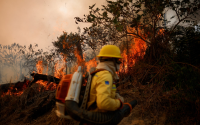24 June 2006Bill Blakemore
It seems to make no sense: Record drought, right next to downpours. Just this week, for example, swaths of Arizona have been on fire and there have been flash floods in Texas.
But to scientists, it does make sense.
The simple reason is that the air is getting warmer, and warmer air holds more moisture -- so when the warmer winds sweep across wet farmlands, they suck up more moisture drying the farms out.
And when the winds finally dump that moisture out as rain, the downpours are much heavier.
"Suddenly you've got a gully-washer," says Kevin Trenberth, a scientist with the National Center for Atmospheric Research, part of a research collaboration among universities. "You've got too much water. And then at other times you've got drier conditions, potential for drought -- associated with global warming because of this increase of water vapor in the atmosphere."
That can translate into more rain or more snow -- as was the case this winter in the western mountains.
Normally, more snow is good news for farms and towns below the mountains, because three-fourths of the West's water comes from snow pack.
But a warming trend over the past 30 years means snows often melt out weeks too soon, leaving drier summers, like this year.
On a hot day in the mountains with the snow melting fast, someone might be tempted to see the weather as a sign of global warming and climate change. But of course it's not, all by itself. There are natural cycles of earlier and later snow pack melting.
Global Changes
Plus, as scientists point out, weather is not climate.
Weather is local, whereas climate is a long-term pattern over a large region. Extremes in the past -- like the Dust Bowl in the 1930's -- happened in only one region at a time.
However, what worries scientists now is that these climate extremes are global.
For instance, wildfires over the last five decades are soaring in the United States and the other continents, according to data from the Millennium Ecosystem Assessment, an authoritative report involving consensus from many established scientists. The same goes for floods. And precipitation for the planet as a whole is up 20 percent.
So, say scientists, for the coming decades we must get ready for more frequent extremes of too dry, and too wet.






